The Road to Tsho Rolpa

“काग काग (Caw Caw),” echoed from the top of the tree. My trekking buddy, Anirudra, looked up and remarked, “It’s a high-altitude crow. Its call and color are different from the ones we usually see in the Kathmandu Valley.” I nodded and added, “Just like that, the tone and body structure of people living in the mountains, Terai, or valleys differ as well.”
After a long, grueling trek, reaching Tsho Rolpa at 4,580 meters felt like stepping into a dream. The shimmering glacial lake, cradled by towering snow-capped peaks, was a sight that filled my heart with joy and relief. Every step of the journey was worth it. The cool, crisp air brought a sense of peace, and the memory of happiness settled deep within me as I gazed at nature’s untouched beauty. However, it was strange to see that most people around me explored the scenery through the screens of their mobile phones, capturing moments instead of truly experiencing them with their own eyes. It felt like I had found a treasure they had only glimpsed.

Earthquake in the Bed
I was waiting in Chabahil, Kathmandu, for my travel buddy to arrive so we could begin our journey by bus. It was already getting late, and after calling him multiple times without a response, I started to think he might have canceled the trek. Finally, on my last call attempt, he picked up. “I’m on my way, just wait 10 more minutes,” he said.
“I was in a deep sleep, completely forgetting about the trek. It felt like an earthquake had jolted me awake, but it was actually my phone vibrating on the bed,” Anirudra explained on the bus.
Highway to Hell
According to the bus driver, the journey was supposed to take 10 hours. The drive from Chabahil to Chet Chet felt like a descent into chaos; the road conditions were terrible, with many sections left unmaintained or severely damaged by floods and landslides from late September 2024. Midway through, we received news of a landslide blocking the road just before Dolalghat. The driver had to take a detour through Melamchi to reach Dolalghat. This alternative route was treacherous and hardly suitable for such a large bus. By the time we finally arrived in Chet Chet, where our trek would begin, nearly 12 hours had passed.

Baahubali, The Beginning
A few minutes before reaching Chet Chet Bus Park, we spotted a majestic waterfall cascading down the mountainside, just like in the Bollywood movie Baahubali. The sight was mesmerizing, and we couldn’t resist capturing videos through the bus windows as we passed by.



Upon reaching Chet Chet in the evening, we took a short break to refresh ourselves and then began our trek. The weather was perfect, and we were joined by a lively group of other trekkers. Another waterfall greeted us, its thundering roar echoing through the valley as we neared the suspension bridge. Crossing over, we could hear the powerful rush of water from the Tamakoshi River below. As darkness settled, we prepared for a 2-3 hour uphill trek to Simigaun. With head torches on, we moved slowly, chatting with fellow trekkers about the journey ahead, exchanging stories and laughs with strangers under the stars.

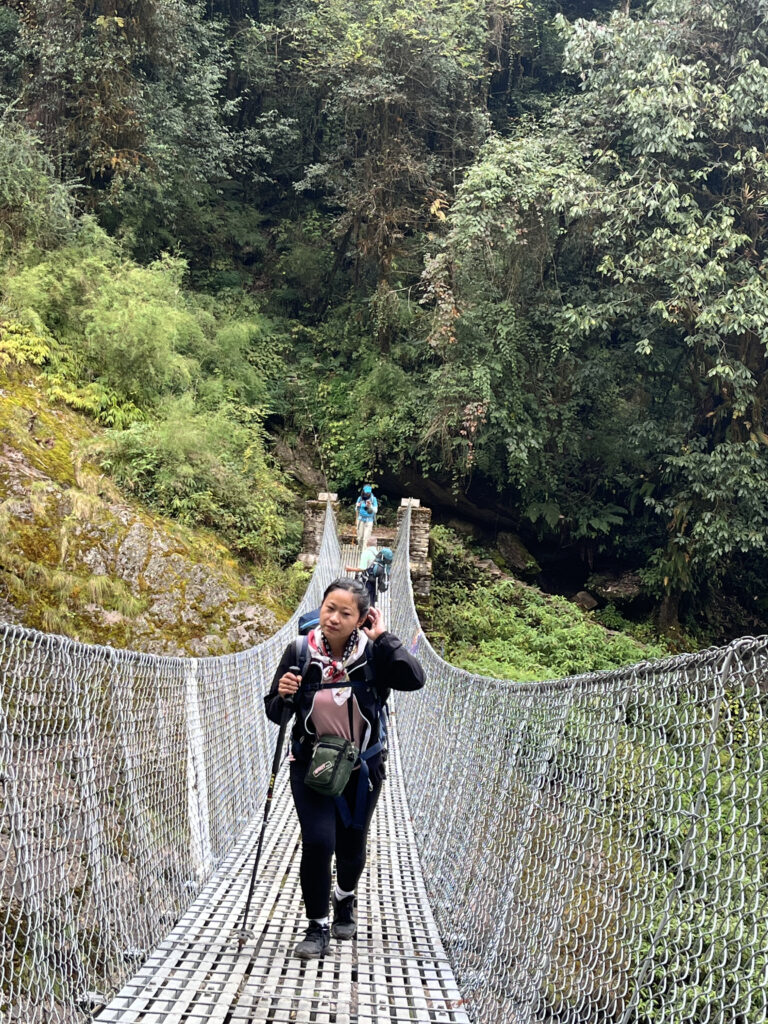

As we approached Simigaun, we spotted glittering lights in the distance. “Finally, we’ve reached Simigaun,” I thought but it was just the start of the village. We trekked another half hour in the dark, carefully finding our way until we arrived at our destination, Hotel Mitini. The place was packed with other travelers, but we managed to secure a room. After a hearty dinner and some lively conversations with other trekkers, we headed to bed. There was no electricity beyond this point, so we charged our gadgets while we could and drifted into the world of dreams.

Flood & Landslide
‘Simigaun’ derives from “Simi,” meaning beans, and “Gaun,” meaning village. According to a local legend, long ago, a group of hunters came to this area to hunt wild animals. While there, some beans they had in their pockets fell to the ground. When they returned the following year, they found bean plants growing in the same spot and named it Simigaun. On treks like these, you often hear such stories. Whether or not you believe them, listening to the villagers’ tales makes for memorable experiences.
We woke up at 5:00 am and completed our morning rituals. For most trekkers, the day’s destination was Simigaun to Bedding; a challenging 8-hour hike that would take us from 1900m to an elevation of 3650m. Many of us had watched numerous videos of the Tsho Rolpa trek on YouTube, but we were surprised to learn that, due to flooding and landslides in July 2024, parts of the trail had been damaged. The villagers had created some temporary detours, making the route longer than before.
Though my goal was Bedding, a part of me felt drawn to Thang Dingma (3344m) instead. My mind said Bedding, but my heart whispered Thang Dingma.



The Steep Ascent to Uttise
As we set off, the trail climbed sharply, but the path was well-equipped with stairs and railings, making the steep ascent safe and manageable. There were plenty of shelters and rest stops along the way, so we took breaks for water and to rest whenever we came across one. Anirudra and I shared stories of past trekking adventures as we walked. He’s a slower hiker, while I tend to be faster, but I’d promised to match his pace for this trip.



The Journey Beyond Uttise
The Rolwaling River flowed alongside us as we trekked, with the mountain ahead appearing as if it wore a traditional Nepali cap, snow covering only its peak. We hiked past the mountain’s base, reaching a suspension bridge after about an hour. There, we paused to take photos and videos with a friendly group, including four cheerful girls. After crossing the bridge, we turned left, continuing to Lower Uttise, where we found only one closed teahouse. We moved on and soon found a small hut in Upper Uttise. Our next destination, Surmuche (2,480m), lay four kilometers ahead, about a two-hour walk from Lower Uttise.


The Secluded Path to Surmuche
As we trekked onward, the path became more secluded, surrounded by dense forests and the occasional clearing revealing sweeping views of the towering peaks in the distance. We passed a few solitary houses, adding to the sense of tranquility that enveloped the trail. The steady climb gradually became steeper, yet the air was cool, and the surroundings so mesmerizing that we barely noticed the exertion.
The trek from Uttise to Surmuche started with a gentle ascent through lush forests, filled with the sounds of birds, rivers, and waterfalls, with only a few houses scattered along the path. The snow-capped peaks of Gaurishankar greeted us like a welcoming smile. Upon reaching Surmuche, we saw a sign reading “Welcome to Surmuche” and rested at “Surmuche Hotel.” We were traveling the day after Dashain Tika, a major Nepali festival, and discovered that during September and October, over 70 people trek to Tsho Rolpa daily. Many strangers became friends on this trail.
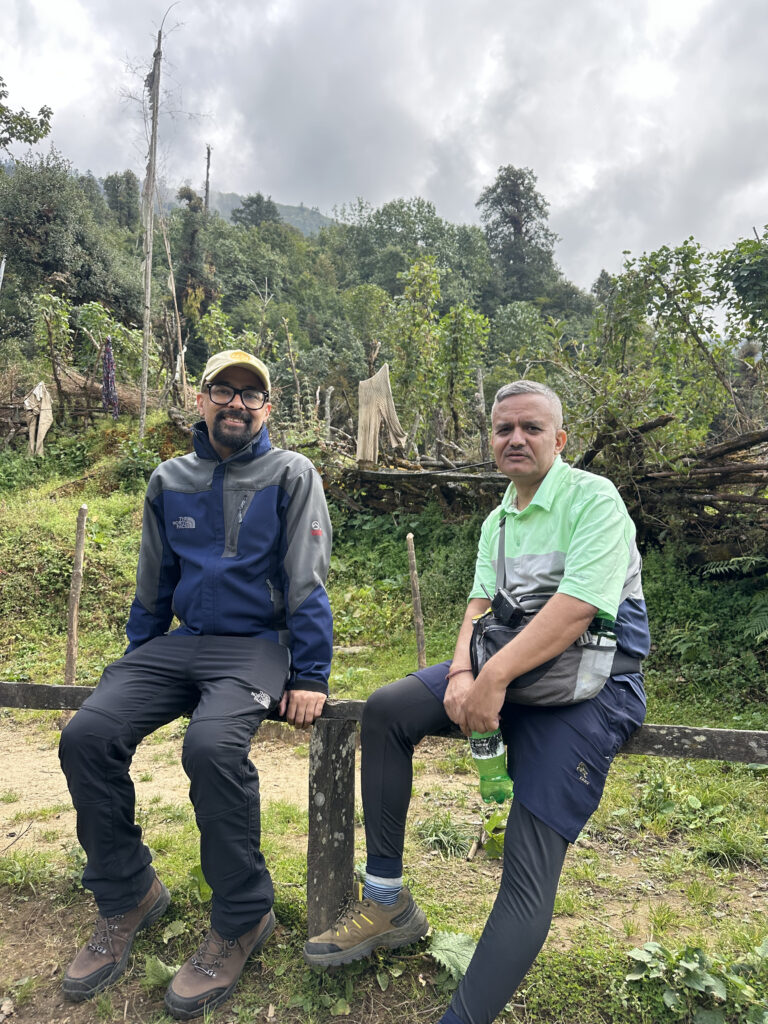



Card Games and Festivities
During Dashain and Tihar, card games are a tradition, so we joined the same four girls for a game of cards over tea and biscuits. I don’t remember who won, but I know I lost! Then, we continued on toward Kyalche (2,740m), a 1.5-kilometer, easy trail that we covered in about 45 minutes. We ordered dal-bhat, and while waiting, Anirudra urged us to play cards again. In this region, killing animals is prohibited, making it a no-kill zone beyond Simigaun, so we enjoyed a vegetarian meal of rice, lentils, and curry.



The Decision to Stay in Thang Dingma
“You won’t make it to Bedding today, and there are only a few teahouses in Thang Dingma,” the owner of Kyalche Lodge informed a couple from Kirtipur. That settled it for us, we’d stay in Thang Dingma. Feeling pressed for time, we picked up the pace, though the waterfalls, rivers, and lush forests along the way made it tempting to slow down and savor the scenery. After almost three hours and four kilometers, we finally reached Dongang (2,780m). Anirudra and Rachana hadn’t arrived yet, so Samjhana, Manisha, Sunkeshi, and I waited for them there.
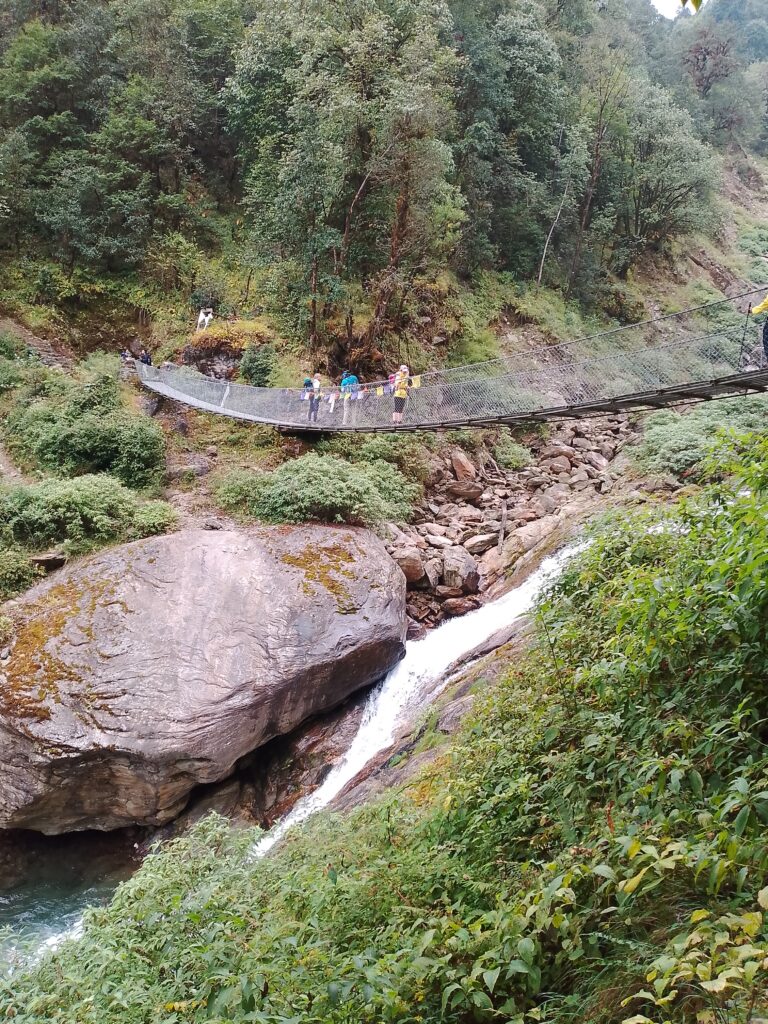


Dongang: Flood Leaves No Trace of the Village’s Existence
The flood left nothing behind except one damaged, empty tea house, which wasn’t even visible when we took the same route back. We’re now forced to use a temporary trail, starting in the sandy riverbed. The rivers could easily change course. All six of us walked slowly, sometimes along the river, sometimes on muddy paths, searching for trail signs. Our goal was Thang Dingma (3330m), 5.3 kilometers away. According to the signboard, it should have taken us about 2 hours and 45 minutes. But with the damaged trails, it was taking far longer, and the sky was getting darker.



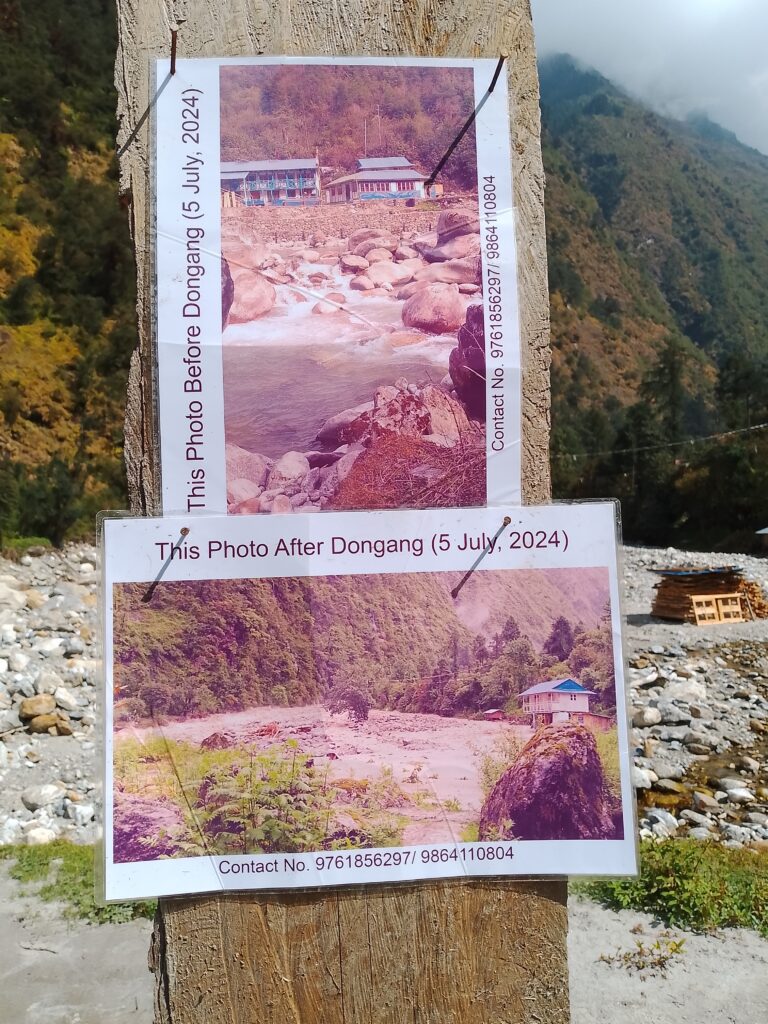

Struggling Through the Darkness
Rachana, exhausted and reluctant to continue, walked with Anirudra and me. The other three girls were slightly ahead. In the dark, we suddenly reached a dead end with no visible trail markers. Then we spotted a blinking flashlight on the other side of the river. “डूबने वाले के लिए तिनके का सहारा ही काफी होता है।“ For one who is drowning, even a straw feels like a lifeline, I thought as all three of us felt a surge of hope but where to cross the river? After searching for a bit, we finally found a temporary bridge.
Reaching Thang Dingma
We continued, and soon the four girls joined us. We also came across a girl from Chitwan whose group had gotten lost somewhere in the forest. We advised her to join us rather than waiting alone. After another half hour of uphill trekking, we finally saw a signboard: we had reached Thang Dingma. It was nearly 7:30 pm, and the few tea houses there were almost full. The owner found us a place where we could sleep for the night.


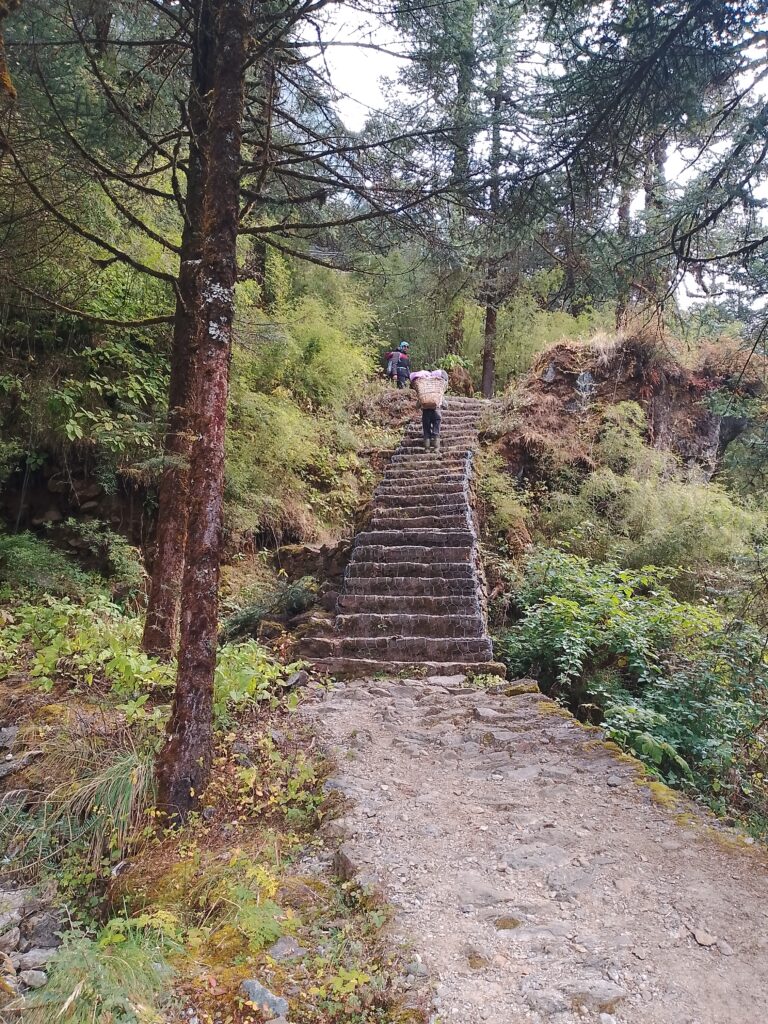
A Close Call
Anirudra had developed a fever, so I went to the kitchen to order tea and cancel our dinner. Just then, I noticed the four girls with their backpacks, ready to continue trekking toward Bedding. I called out to them, “Are you guys crazy? If you walk now, you’ll reach at midnight or later it’s too risky!” Thankfully, they decided to cancel their plan.
Journey to Bedding and Na Village: A Day in Rolwaling Valley
We woke up early, refreshed from a deep sleep after a long day of trekking. The room we stayed in was basic, with no windows, light, internet, or network, but the quiet was perfect for a restful night.
The morning started off a bit tense. The tea house owner seemed to be in a swingy mood, and when Anirudra asked for something, her reply was unexpectedly rude. A quick argument ensued, and we decided to skip breakfast, opting instead to head directly towards Bedding (3,740m), just 6 kilometers away a manageable 3-hour trek.


We asked some villagers for directions, and they mentioned a few spots where the trail was damaged but assured us it would be easier than the previous sections. With the sun shining warmly and the Rolwaling River flowing beside us, we walked on, winding through forests and feeling refreshed by nature’s beauty. The mountains around us stood tall, capped like a traditional Nepali topi, seeming to join us in our journey. There were even lighthearted moments as we stopped to rest in the forest, with the towering peaks providing a private backdrop.


Arrival in Bedding: A Village Frozen in Time
Reaching Bedding felt like stepping back in time. At 3,700 meters, this Sherpa village is the largest in the Rolwaling Valley, with its traditional stone houses, terraced fields, and the slow rhythm of village life. We paused here for a much-needed two-hour break, enjoying the warm hospitality. Lunch was a hearty spread of traditional Dal Bhat and Thukpa, filling us with energy. Afterward, we gathered with fellow trekkers, including a friend from Bhaktapur, for a lively game of cards, sharing stories and laughter.

Just before arriving in the village, we passed the Rolwaling Sanga Choling Monastery School, nestled in the hills and surrounded by majestic mountain views. Nearby, the Bedding Gompa (monastery) stood as a serene sanctuary, where monks and villagers gather for prayers and festivals, adding to the village’s deep-rooted spiritual atmosphere.
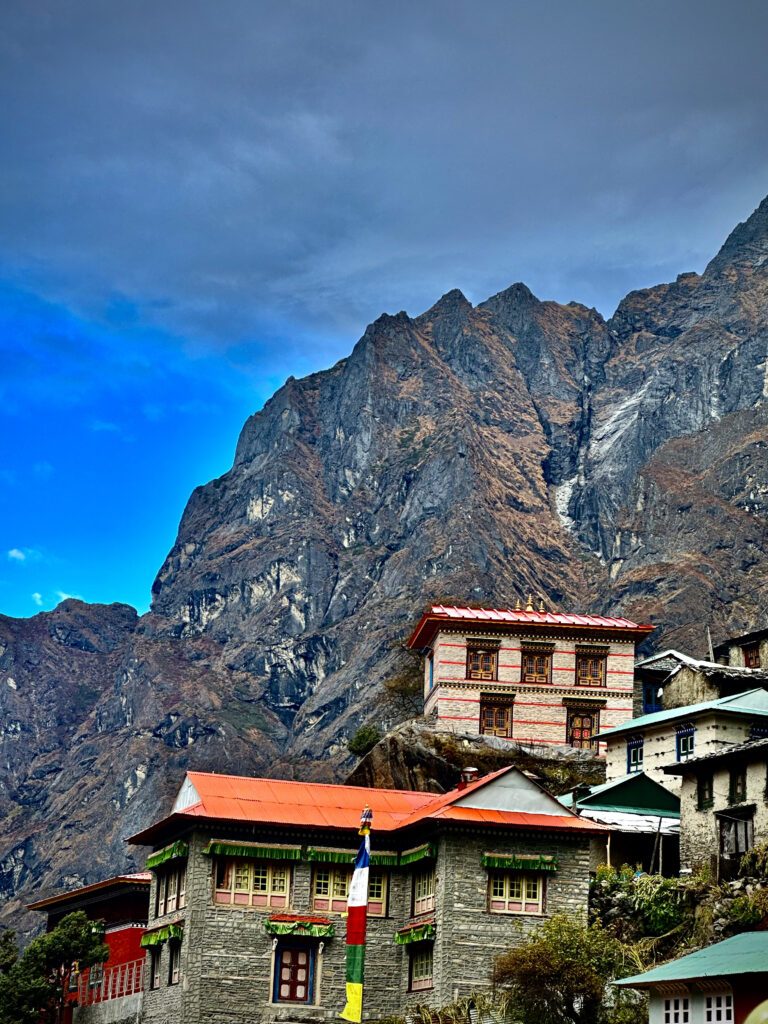

After our break, we were ready to head to Na Village (4,180m), another 4.5 kilometers and a maximum two-hour hike. Manisha and I took the lead, with the others following closely behind.

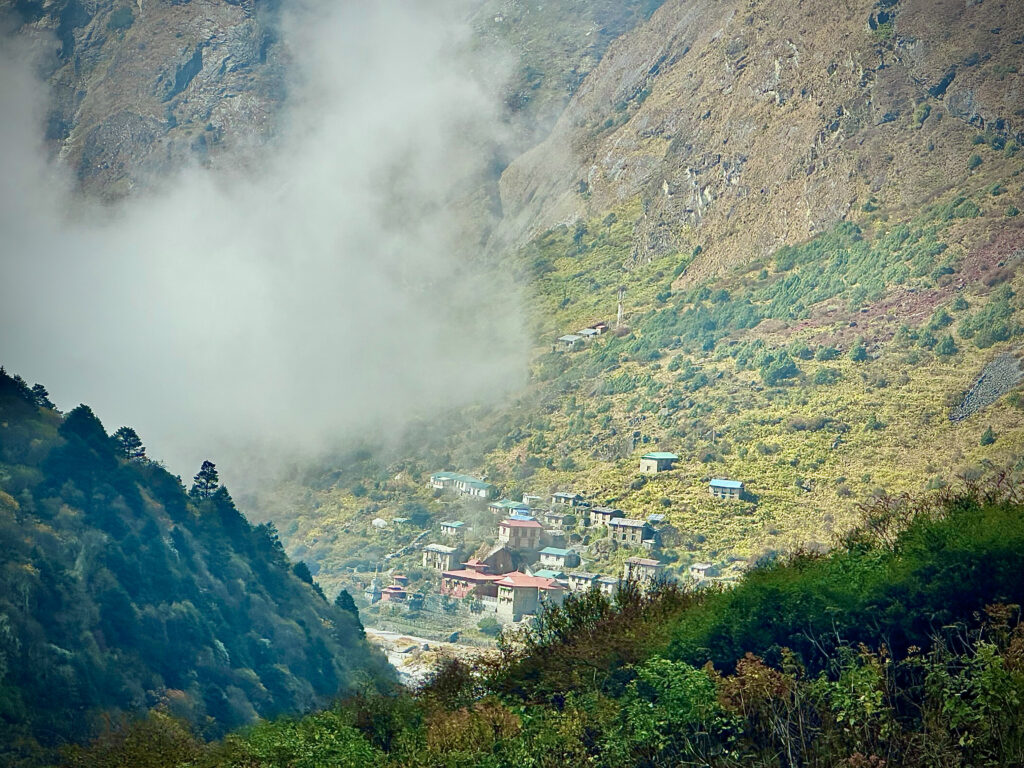
Na Village: A Seasonal Mountain Hamlet
By evening, we reached Na, a seasonal settlement often used for high-altitude grazing and as a base for mountaineering activities. Bedding, with its larger population and more permanent structures, serves as the valley’s central hub, but Na is a quieter, simpler place, particularly in colder months.
Once there, Manisha and I searched for a place to stay while we waited for the others, who had lagged behind. After about half an hour, they arrived, and we settled in at an altitude of 4,180 meters cold but cozy. The girls enjoyed chatting with other trekkers around the fire in the kitchen, though we cautioned them about staying too close to the flames, as the low oxygen at this altitude can quickly cause headaches. Unfortunately, Rachana developed one, likely from the altitude.
After a warm dinner, we called it a night, drifting off to sleep, recharging for the next day’s adventure in the high Himalayas.
The Challenges of a Beautiful Life in Na Village
We woke up early, greeted by the sight of Na Village, and nestled among rugged, towering Rocky Mountains. Everything here feels untouched and serene, and the purity of the surroundings is breathtaking. Living in such a remote place immerses you fully in nature’s beauty the quiet, the peace, and the proximity to these incredible landscapes. It’s mesmerizing, yet life here is anything but easy.
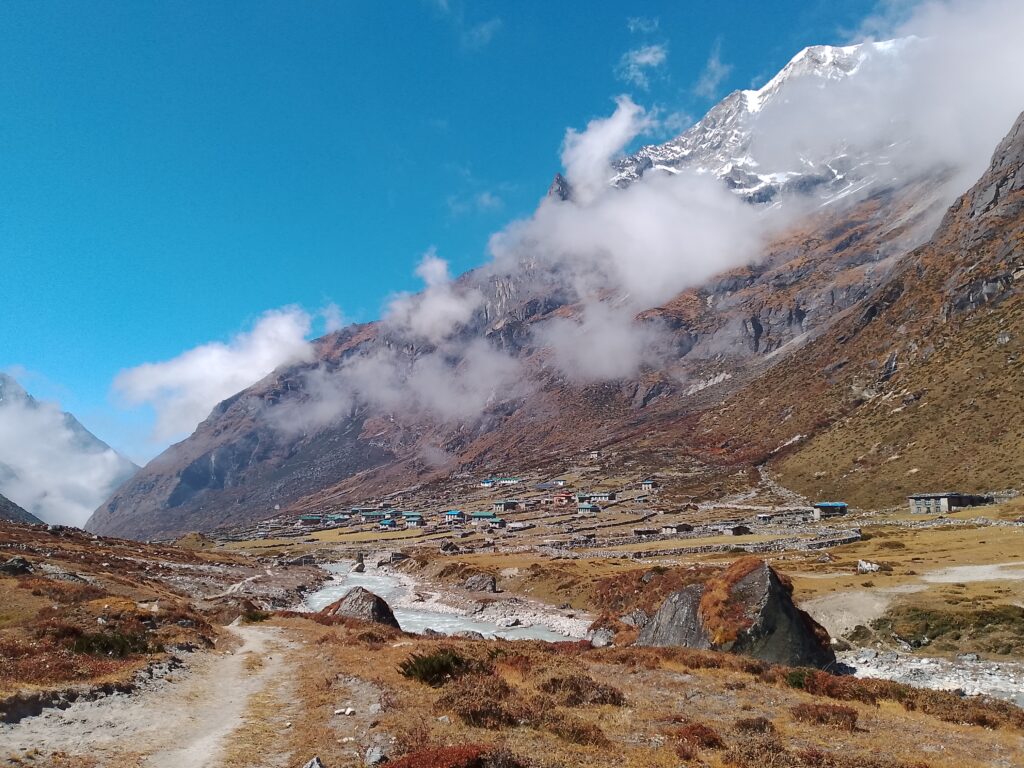
During the harsh winter months, most villagers move down to Bedding, where conditions are slightly more manageable. For seasonal trekkers like us, the raw beauty of Na Village is magnetic, drawing us into an adventure-filled atmosphere. Every day brings a sense of excitement and challenge.
But what is day-to-day life like in this remote village? Life here is a blend of simplicity and resilience. Without modern conveniences, villagers rely on hardy crops, livestock, and the resources they gather from the land. Daily routines are shaped by the rhythm of the mountains and the valley. Despite the challenges, the Sherpa community remains deeply connected to the landscape, thriving through shared traditions, mutual support, and their spiritual connection to the land.
For visitors, the beauty of Na is captivating, but for the locals, it’s a demanding way of life where nature is both a provider and a test of endurance.
Tsho Rolpa Lake (4580m): A Glacial Marvel in Nepal’s Rolwaling Valley
Tsho Rolpa Lake, situated at an impressive altitude of 4,580 meters, is Nepal’s highest glacial lake, nestled in the stunning Rolwaling Valley of Dolakha District. Surrounded by towering Himalayan peaks, it offers breathtaking views and an unforgettable experience.

The Tsho Rolpa Trek follows the Rolwaling Valley trail, passing through the serene Gaurishankar Conservation Area, enhancing its natural beauty. Classified as a moderate trek, it’s accessible for beginners and doesn’t require prior trekking experience, making it an ideal choice for newcomers to high-altitude trekking.



Challenges Along the Way
Our group encountered a few challenges along the way. Rachana decided to stay behind in Bedding, and Manisha suffered from bouts of vomiting due to altitude sickness. Despite her condition, Manisha encouraged us to complete the trek. Anirudra and I, along with Manisha, Samjhana, Sunkeshi, a couple from Kathmandu, and three friends from Bhaktapur and Kathmandu, continued towards Tsho Rolpa.
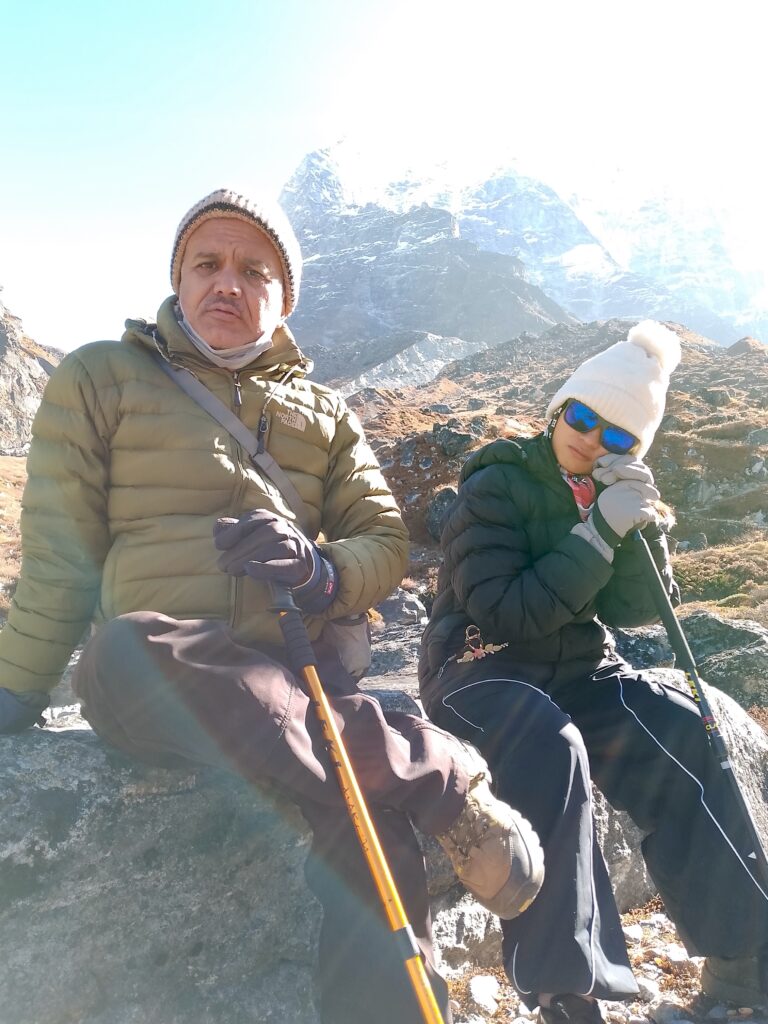
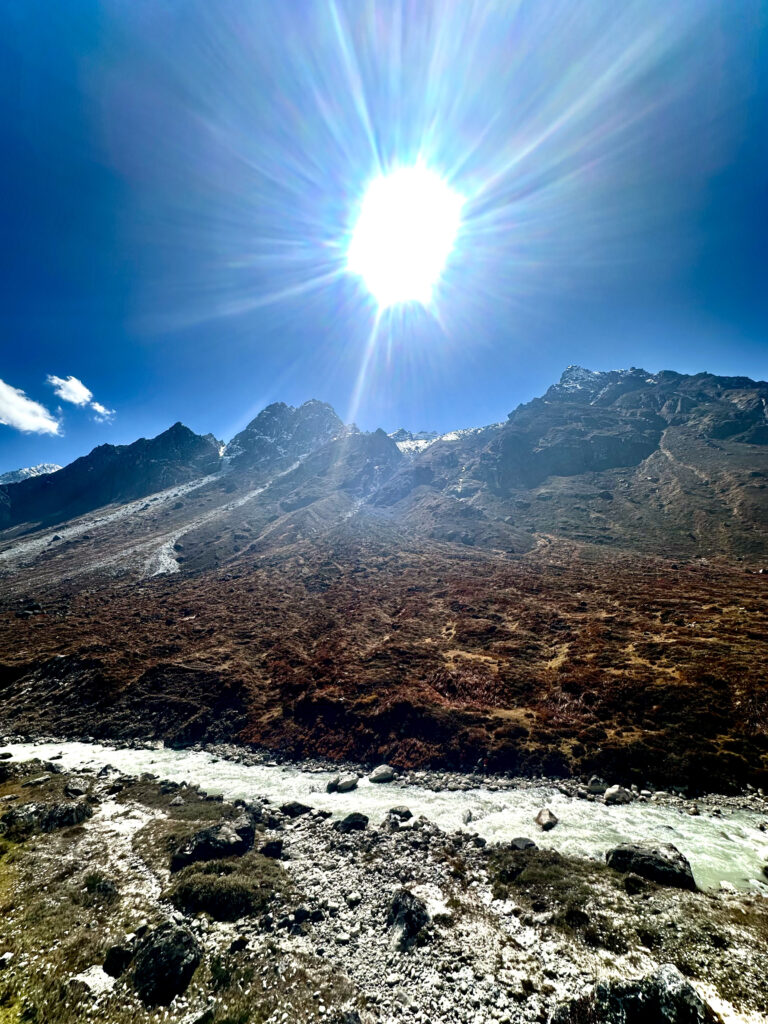

Final Push to Tsho Rolpa
Some of our group planned to trek to Dudha Kunda first, but a lack of guides in the early morning made it difficult. Ultimately, we all focused on reaching Tsho Rolpa, a 2.5-hour journey from Na Village. The path was manageable but involved steady uphill walking. We passed many trekkers heading both to and from Tsho Rolpa.


Reaching the Destination: Tsho Rolpa Lake
After nearly an hour, some fellow trekkers pointed out the mountain ahead, saying, “That’s your destination.” Though it seemed close, the winding path made the journey longer. Manisha, struggling with altitude sickness, vomited multiple times. I suggested she rest until Anirudra and Sunkeshi caught up. Finally, after a demanding trek, arriving at Tsho Rolpa felt like entering a dream.


The crystal-clear glacial lake, surrounded by majestic snow-covered peaks, filled me with a profound sense of joy and accomplishment. I took in the view and captured it both mentally and on my phone. In a spontaneous moment, I posed for a topless photo taken by Dhirendra Ghimire from Bhaktapur. Later, my family humorously remarked on the “six-pack” I seemed to have in the picture!

Regrouping and Descent
Manisha eventually arrived and lay down on a large rock, exhausted. I advised her to head back down as soon as she felt able, given her altitude sickness. As she made her way down, a few of us took more photos around the lake. Throughout the trek, Sunkeshi, Manisha, and Rachana captured countless photos of me and Anirudra.

Return to Na Village
We then began our descent back to Na Village. Anirudra and I paired up, while Sunkeshi and Samjhana teamed up. Descending was noticeably easier, and about an hour in, we learned that Samjhana had joined four others to trek to Dudha Kunda, while Sunkeshi returned alone. Fortunately, we had walkie-talkies with us, so we could reassure Sunkeshi as she made her way back. Rachana and Manisha welcomed us at Na Village, where we enjoyed a hearty meal of Rara (noodles).


Reflecting on the Tsho Rolpa Adventure
The journey to Tsho Rolpa was an adventure that challenged and rewarded us in equal measure.

Night at Bedding
It took some time to arrange for Samjhana to return to Bedding. Meanwhile, Rachana and Sunkeshi wanted to wait for her in Na Village. Sometimes Rachana felt like staying; sometimes Sunkeshi did. They both took some time to decide on their plans. I told them to do whatever they wanted and that we should keep moving. Anirudra also didn’t want to return. If we waited, we would have to walk a long way back. Eventually, they wrote notes for Samjhana, and we all continued on to Bedding.

We stayed in the same hotel where we had lunch the day before. All of us felt relaxed, and about ten or eleven of us played cards in the dining hall. I usually avoid alcohol until we reach our final destination, so I tried two glasses of local drinks in Bedding, and it was fantastic. Before sleeping, we gathered once more to play cards. Anirudra kept urging us to play, saying it was festival time.
Day Five
Anirudra and I woke up early and had breakfast before starting our journey back to Chet Chet. Once again, there was a bit of drama; Samjhana did not arrive, and we were supposed to wait two more hours for her. I suggested to Anirudra that we start walking and let her catch up, but he only seemed willing to move if Rachana walked with him.

Manisha, Dhirendra, and I decided to move on together. Manisha and Dhirendra were walking quickly, so I matched their pace. We took a shortcut from Thang Dingma to Dongang. The mobile network was patchy, but whenever I got a signal, I updated Anirudra, letting him know that we were heading towards Chet Chet so we could catch the 5:00 am bus back the next day.


As we walked from Simigaun to Chet Chet, we were able to appreciate the beauty of Simigaun—a view we had missed on the first day when we passed through in the dark. Meanwhile, Sunkeshi and Samjhana made it to Simigaun, but Anirudra and Rachana got lost. As night fell, the four of them decided to stay at the same hotel where we’d spent our first night.
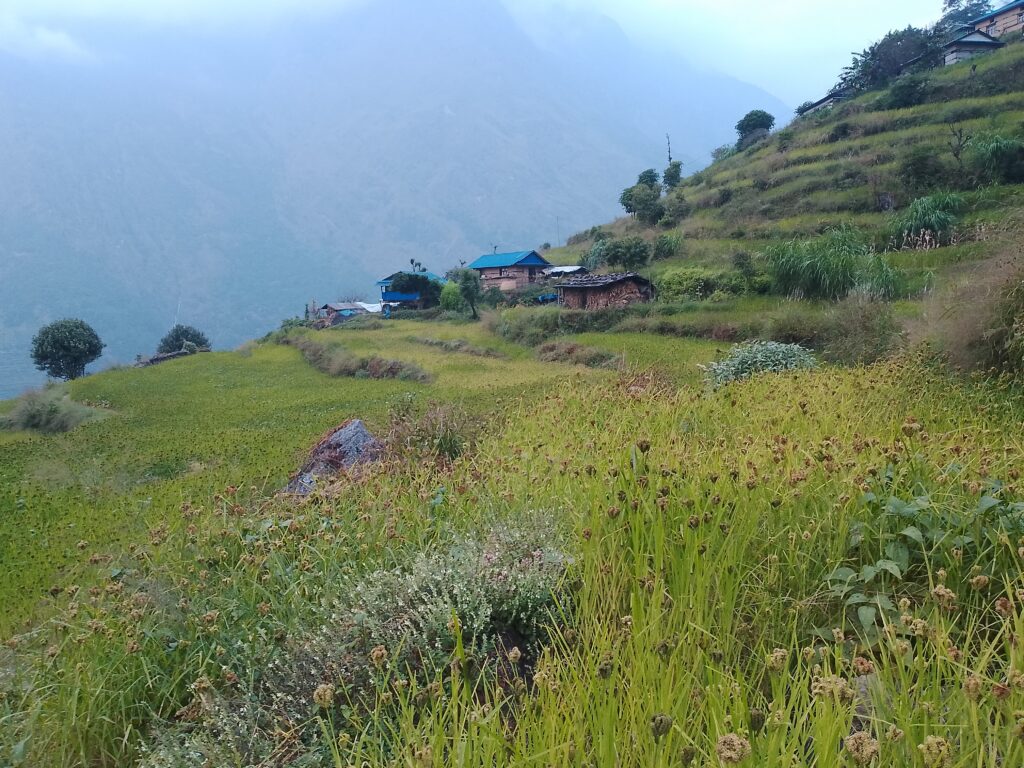

Chicken Curry and Rice
I always crave at least one delicious meal a day, but during the trek, that was rare. I skipped dal bhat the entire way.
“Do you guys want dinner tonight?” asked Sherapni, the hotel owner. I replied, “Do you have any non-veg options?” She nodded. I then asked, “Do you add onions, tomatoes, and ginger to the chicken?” She shook her head, unfortunately.
A group of three guys, Manisha, and I hung out in the kitchen, enjoying some snacks with local drinks. Later, we were served rice with chicken curry. “Finally!” The longing for a satisfying meal was fulfilled that night.
Return Back to Kathmandu
Manisha wanted to stay in Chet Chet to wait for her group, while Anirudra enjoyed the company of the others. I decided to head back since the bus was filled with familiar faces I had met and chatted with during the trek.
Trash Management
Throughout the trek, you’ll find dustbins along the trail, and it’s rare to see any litter. We only spotted trash in two or three spots, likely left by careless visitors.
A gentle reminder: Please carry out your trash. By simply taking back what you brought in, we can keep the trails clean and beautiful for everyone to enjoy. Or, if you come across dustbins along the way, please use them to dispose of your waste responsibly.
Hotels, Toilet and Water
There are no issues with the hotels, toilets, or water along the trek. Even in cases where there might not be immediate accommodation, they will manage to find a place for you. The toilets are clean, and there is no shortage of water.
Conclusions
The Tsho Rolpa trek is an unforgettable adventure through Nepal’s Rolwaling Valley. Despite challenges like damaged trails, altitude sickness, and unpredictable roads, the journey is filled with awe, camaraderie, and reflection. From the tough trek to the peaceful Tsho Rolpa Lake, the stunning scenery towering peaks, waterfalls, and serene landscapes highlights Nepal’s natural beauty.
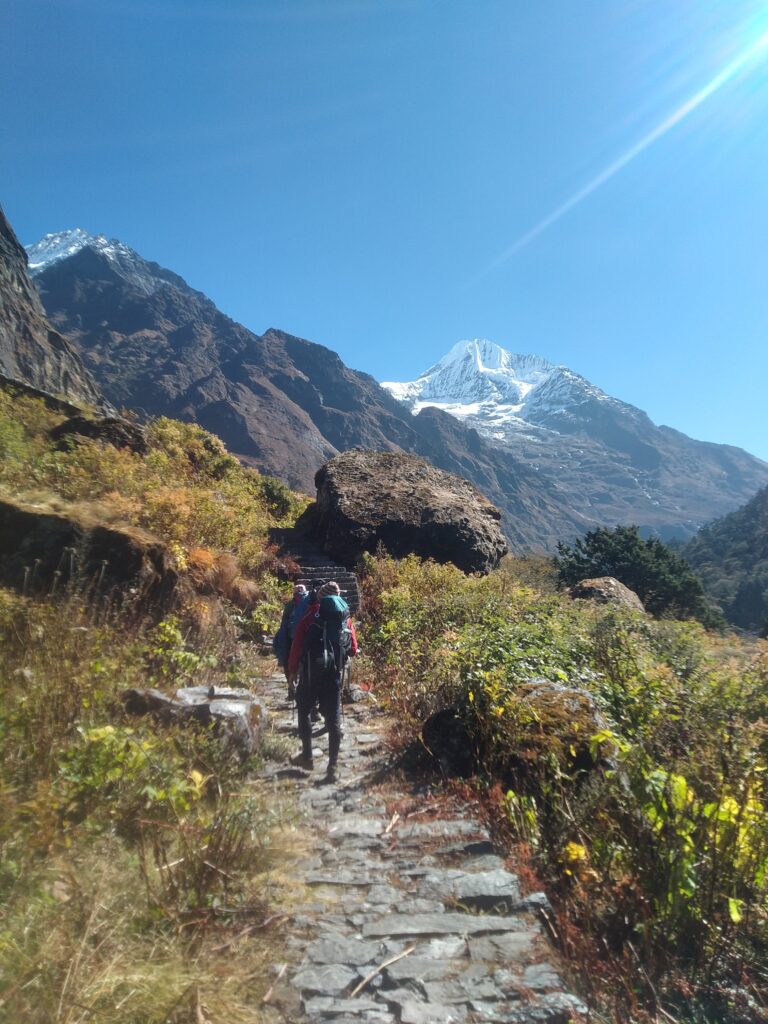








Photo Credit: Gautam Shrestha (Jhilke Hulaki), Sunkeshi, Rachana & Dhirendra



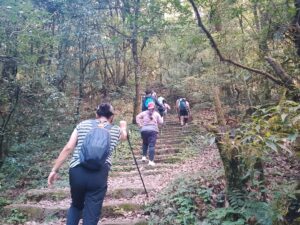

Wonderful…it was so amazing to be a part on this trail with you guys though it for a short. Thankyou so much dai for being side by side during trail. And the trail detail explanation is so fabulous..
Your description of the trek is captivating—it’s as if I could feel both the serene beauty of nature and the challenges of conquering it. It truly makes me long for a life closer to the wild, where nature’s rhythms guide every step.
So glad to be a part of your journey Dai and for a moment this article took my soul back into my memories and remind me how amazing this trek was with you guys!
Thank you for sharing such a beautiful and informative article with all important details and memories.
Your description of the trek is captivating—it’s as if I could feel both the serene beauty of nature and the challenges of conquering it. It truly makes me long for a life closer to the wild, where nature’s rhythms guide every step.
Thank you so much for your excellent article! I am hoping to go already on Monday 🙂
Could you most kindly share the details to find the bus to Chetchet!? Thank you
You can catch up bus from Chabahil. but you have to reached before 5:00am
I’m Amazed about your writing skills it’s wonderful and also an inspiration for us.
When I study this artical I went in the past and refreshed all our beautiful memories.
We’re glad to meet you and the principal sir (Anirudra sir) we’ve made fabulous memories together.❣️
Hope soon to be together for next trip.❣️
Looking at the pictures and your description it must have been a memorable experience. Enjoy life to the fullest.
Thank you so much, Big Brother, for the wonderful article about our trek. The way you captured our experiences and highlighted the bond we shared truly warmed my heart. I’m especially grateful for the thoughtful mention of me—it means a lot and makes me feel part of something special. Your words brought back so many cherished memories, and I deeply appreciate the effort you put into this beautiful reflection.
Very interesting! Enjoyed reading about your trip Jhilke Hulaki! It’s amazing. Wish I could have joined you guys!!
It brings back fond memories of my very first trek back in September 1998, when I undertook the 23-day trek through the Rolwaling Yalung La Pass. Keep sharing your updates, Gautam Ji!
यो यात्रा वर्णन धेरै रोमाञ्चक लाग्यो। प्राकृतिक सुन्दरताको अनुभव गर्दा मानिसहरू मोबाइल स्क्रिनमा केन्द्रित रहेको देखेर अचम्म लाग्यो। त्यसरी प्राकृतिक सुन्दरताको अनुभव गर्ने बदल गर्नुपर्छ कि? यात्राका समयमा सडकको अवस्था धेरै नराम्रो भएकोले यात्रा असुविधाजनक भयो। के यो यात्रा पछि त्यस क्षेत्रको सडक मर्मत गर्ने योजना छ?